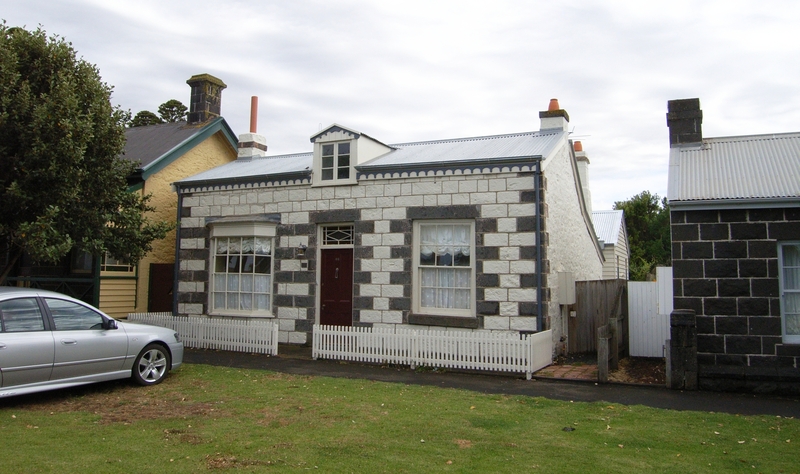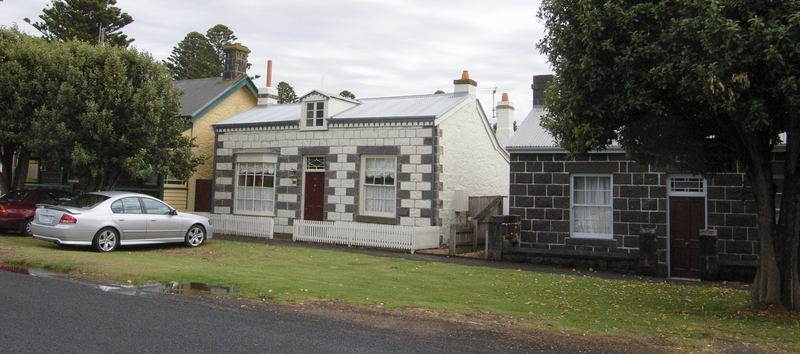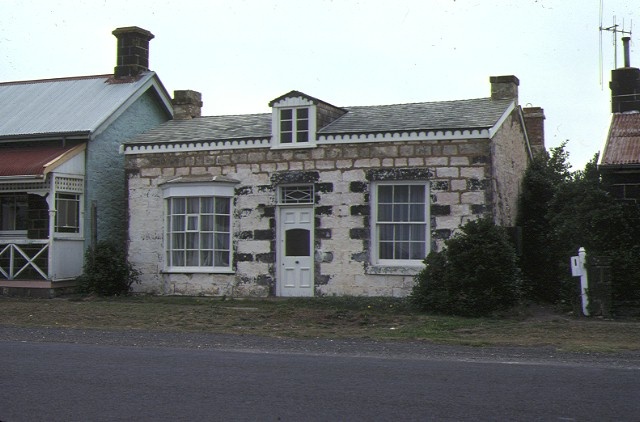COTTAGE
66 CAMPBELL STREET PORT FAIRY, MOYNE SHIRE
-
Add to tour
You must log in to do that.
-
Share
-
Shortlist place
You must log in to do that.
- Download report




Statement of Significance
What is significant?
Norina is located on the southern side of the street grid of Port Fairy and faces the dunes of the South Beach. Mark Tucker, carpenter built the single storey, four-roomed cottage at 66 Campbell Street, Port Fairy, now called Norina at least by 1857. It has a distinctive bay window (formerly with a ventilating pane and possibly intended for the display of goods) and a small dormer window. The cottage is built of coursed limestone with bluestone quoins and has decorative timber detailing at the eaves line and bargeboards. It has the typical form of a cross gable and skillion. In 1896, the cottage was sold to Emily Mandeville, the first owner's daughter and widow of the chemist and Town Clerk, Frederick Mandeville. Later, a local fisherman, William 'Ginger' or 'Meg' Denny and his family owned the house for nearly seventy years. A bull-nosed timber verandah, added after 1900 with a glazed sleep-out used by Ginger, was removed in 1975. The cottage retains a high degree of integrity from the late nineteenth and early twentieth century periods, but with no original decoration. It remains in good condition. From the 1970s, Norina has been used as a holiday cottage.
How is it significant?
The cottage at 64 Campbell Street, Port Fairy is of architectural and historic important to the State of Victoria.
Why is it significant?
Architecturally, the cottage demonstrates humble vernacular construction techniques and the survival of late Georgian stylistic traditions. The original 'shop' window, the dormer window, the decorative detailing and the internal joinery are of interest. Historically, as part of a group of similar cottages (and one of several surviving within Port Fairy) it reinforces the modest seafaring character of a pioneering town of national significance.
[Online Data Upgrade Project 2001]
-
-
COTTAGE - History
REGISTER OF THE NATIONAL ESTATE - CITATION THE FOUR ROOM ATTIC COTTAGE AT 66
CAMPBELL STREET, PORT FAIRY, WAS CONSTRUCTED OF LOCAL LIMESTONE RUBBLE WITH
BASALT QUOINS AND TIMBER SHINGLE ROOF IN 1856 ON LAND WHICH WAS ORIGINALLY
PART OF JAMES ATKINSON'S SPECIAL SURVEY OF 1843. GEORGE KENYON HOLDEN AND
MARK TUCKER ACQUIRED THE LEASEHOLD IN FEBRUARY 1856 AND APPARENTLY BUILT THIS
COLONIAL GEORGIAN STYLE COTTAGE SOON AFTERWARDS. THE ATTIC COTTAGE AT 66
CAMPBELL STREET, STILL COMPLETE WITH THE CENTRAL ATTIC DORMER, IS A FINE
EXAMPLE OF COLONIAL GEORGIAN VERNACU- LAR BUILDING TRADITIONS IN VICTORIA AND
REPRESENTATIVE OF COTTAGE ARCHITECTURE OF THE FIRST YEARS OF SETTLEMENT IN
PORT FAIRY. THIS LIMESTONE RUBBLE COTTAGE IS UNUSUALLY AND DISTINCTIVELY
ENHANCED WITH BASALT QUOINS AND ARCHITRAVES AND DECORATED TIMBER BARGES IN A
STYLE REMINISCENT OF PATTERN BOOK 'COTTAGE ORNEE'.
THE COTTAGE AT 66 CAMPBELL STREET HAS BEEN REHABILITATED WITH THE ESSENTIAL
CHARACTER PRESERVED INTACT. THE BULLNOSE VERANDAH (C.1900) WAS DESTROYED IN
1975 AND NOT REPLACED. THE INTERIOR DETAILS AND STAIRCASE ARE OF SPECIAL
INTEREST. OF STATE SIGNIFICANCE.COTTAGE - Permit Exemptions
General Exemptions:General exemptions apply to all places and objects included in the Victorian Heritage Register (VHR). General exemptions have been designed to allow everyday activities, maintenance and changes to your property, which don’t harm its cultural heritage significance, to proceed without the need to obtain approvals under the Heritage Act 2017.Places of worship: In some circumstances, you can alter a place of worship to accommodate religious practices without a permit, but you must notify the Executive Director of Heritage Victoria before you start the works or activities at least 20 business days before the works or activities are to commence.Subdivision/consolidation: Permit exemptions exist for some subdivisions and consolidations. If the subdivision or consolidation is in accordance with a planning permit granted under Part 4 of the Planning and Environment Act 1987 and the application for the planning permit was referred to the Executive Director of Heritage Victoria as a determining referral authority, a permit is not required.Specific exemptions may also apply to your registered place or object. If applicable, these are listed below. Specific exemptions are tailored to the conservation and management needs of an individual registered place or object and set out works and activities that are exempt from the requirements of a permit. Specific exemptions prevail if they conflict with general exemptions. Find out more about heritage permit exemptions here.Specific Exemptions:General Conditions: 1. All exempted alterations are to be planned and carried out in a manner which prevents damage to the fabric of the registered place or object. General Conditions: 2. Should it become apparent during further inspection or the carrying out of works that original or previously hidden or inaccessible details of the place or object are revealed which relate to the significance of the place or object, then the exemption covering such works shall cease and Heritage Victoria shall be notified as soon as possible. Note: All archaeological places have the potential to contain significant sub-surface artefacts and other remains. In most cases it will be necessary to obtain approval from the Executive Director, Heritage Victoria before the undertaking any works that have a significant sub-surface component. General Conditions: 3. If there is a conservation policy and planall works shall be in accordance with it. Note:A Conservation Management Plan or a Heritage Action Plan provides guidance for the management of the heritage values associated with the site. It may not be necessary to obtain a heritage permit for certain works specified in the management plan. General Conditions: 4. Nothing in this determination prevents the Executive Director from amending or rescinding all or any of the permit exemptions. General Conditions: 5. Nothing in this determination exempts owners or their agents from the responsibility to seek relevant planning or building permits from the responsible authorities where applicable. Minor Works : Note: Any Minor Works that in the opinion of the Executive Director will not adversely affect the heritage significance of the place may be exempt from the permit requirements of the Heritage Act. A person proposing to undertake minor works must submit a proposal to the Executive Director. If the Executive Director is satisfied that the proposed works will not adversely affect the heritage values of the site, the applicant may be exempted from the requirement to obtain a heritage permit. If an applicant is uncertain whether a heritage permit is required, it is recommended that the permits co-ordinator be contacted.
-
-
-
-
-
EMOH
 Victorian Heritage Register H0252
Victorian Heritage Register H0252 -
FORMER ST ANDREWS PRESBYTERIAN CHURCH AND MANSE
 Victorian Heritage Register H0850
Victorian Heritage Register H0850 -
PORT FAIRY COURT HOUSE
 Victorian Heritage Register H1480
Victorian Heritage Register H1480
-
'Altona' Homestead (Formerly 'Laverton' Homestead) and Logan Reserve
 Hobsons Bay City
Hobsons Bay City
-
-












